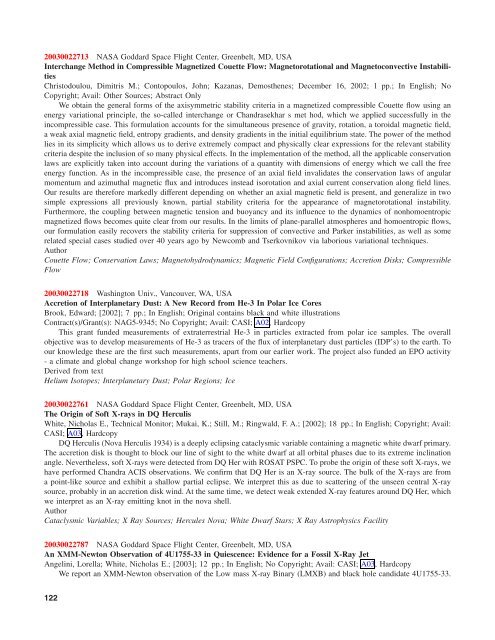You also want an ePaper? Increase the reach of your titles
YUMPU automatically turns print PDFs into web optimized ePapers that Google loves.
20030022713 NASA Goddard Space Flight Center, Greenbelt, MD, USA<br />
Interchange Method in Compressible Magnetized Couette Flow: Magnetorotational and Magnetoconvective Instabilities<br />
Christodoulou, Dimitris M.; Contopoulos, John; Kazanas, Demosthenes; December 16, 2002; 1 pp.; In English; No<br />
Copyright; Avail: Other Sources; Abstract Only<br />
We obtain the general forms of the axisymmetric stability criteria in a magnetized compressible Couette flow using an<br />
energy variational principle, the so-called interchange or Chandrasekhar s met hod, which we applied successfully in the<br />
incompressible case. This formulation accounts for the simultaneous presence of gravity, rotation, a toroidal magnetic field,<br />
a weak axial magnetic field, entropy gradients, and density gradients in the initial equilibrium state. The power of the method<br />
lies in its simplicity which allows us to derive extremely compact and physically clear expressions for the relevant stability<br />
criteria despite the inclusion of so many physical effects. In the implementation of the method, all the applicable conservation<br />
laws are explicitly taken into account during the variations of a quantity with dimensions of energy which we call the free<br />
energy function. As in the incompressible case, the presence of an axial field invalidates the conservation laws of angular<br />
momentum and azimuthal magnetic flux and introduces instead isorotation and axial current conservation along field lines.<br />
Our results are therefore markedly different depending on whether an axial magnetic field is present, and generalize in two<br />
simple expressions all previously known, partial stability criteria for the appearance of magnetorotational instability.<br />
Furthermore, the coupling between magnetic tension and buoyancy and its influence to the dynamics of nonhomoentropic<br />
magnetized flows becomes quite clear from our results. In the limits of plane-parallel atmospheres and homoentropic flows,<br />
our formulation easily recovers the stability criteria for suppression of convective and Parker instabilities, as well as some<br />
related special cases studied over 40 years ago by Newcomb and Tserkovnikov via laborious variational techniques.<br />
Author<br />
Couette Flow; Conservation Laws; Magnetohydrodynamics; Magnetic Field Configurations; Accretion Disks; Compressible<br />
Flow<br />
20030022718 Washington Univ., Vancouver, WA, USA<br />
Accretion of Interplanetary Dust: A New Record from He-3 In Polar Ice Cores<br />
Brook, Edward; [2002]; 7 pp.; In English; Original contains black and white illustrations<br />
Contract(s)/Grant(s): NAG5-9345; No Copyright; Avail: CASI; A02, Hardcopy<br />
This grant funded measurements of extraterrestrial He-3 in particles extracted from polar ice samples. The overall<br />
objective was to develop measurements of He-3 as tracers of the flux of interplanetary dust particles (IDP’s) to the earth. To<br />
our knowledge these are the first such measurements, apart from our earlier work. The project also funded an EPO activity<br />
- a climate and global change workshop for high school science teachers.<br />
Derived from text<br />
Helium Isotopes; Interplanetary Dust; Polar Regions; Ice<br />
20030022761 NASA Goddard Space Flight Center, Greenbelt, MD, USA<br />
The Origin of Soft X-rays in DQ Herculis<br />
White, Nicholas E., Technical Monitor; Mukai, K.; Still, M.; Ringwald, F. A.; [2002]; 18 pp.; In English; Copyright; Avail:<br />
CASI; A03, Hardcopy<br />
DQ Herculis (Nova Herculis 1934) is a deeply eclipsing cataclysmic variable containing a magnetic white dwarf primary.<br />
The accretion disk is thought to block our line of sight to the white dwarf at all orbital phases due to its extreme inclination<br />
angle. Nevertheless, soft X-rays were detected from DQ Her with ROSAT PSPC. To probe the origin of these soft X-rays, we<br />
have performed Chandra ACIS observations. We confirm that DQ Her is an X-ray source. The bulk of the X-rays are from<br />
a point-like source and exhibit a shallow partial eclipse. We interpret this as due to scattering of the unseen central X-ray<br />
source, probably in an accretion disk wind. At the same time, we detect weak extended X-ray features around DQ Her, which<br />
we interpret as an X-ray emitting knot in the nova shell.<br />
Author<br />
Cataclysmic Variables; X Ray Sources; Hercules Nova; White Dwarf Stars; X Ray Astrophysics Facility<br />
20030022787 NASA Goddard Space Flight Center, Greenbelt, MD, USA<br />
An XMM-Newton Observation of 4U1755-33 in Quiescence: Evidence for a Fossil X-Ray Jet<br />
Angelini, Lorella; White, Nicholas E.; [2003]; 12 pp.; In English; No Copyright; Avail: CASI; A03, Hardcopy<br />
We report an XMM-Newton observation of the Low mass X-ray Binary (LMXB) and black hole candidate 4U1755-33.<br />
122
















